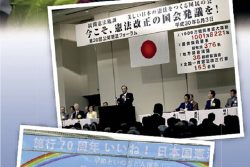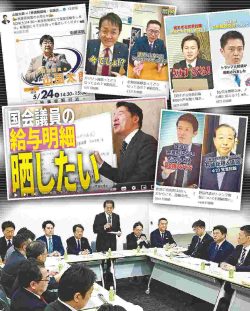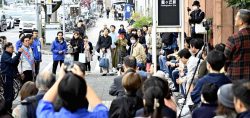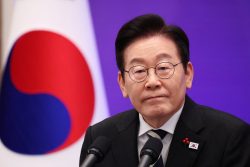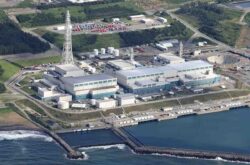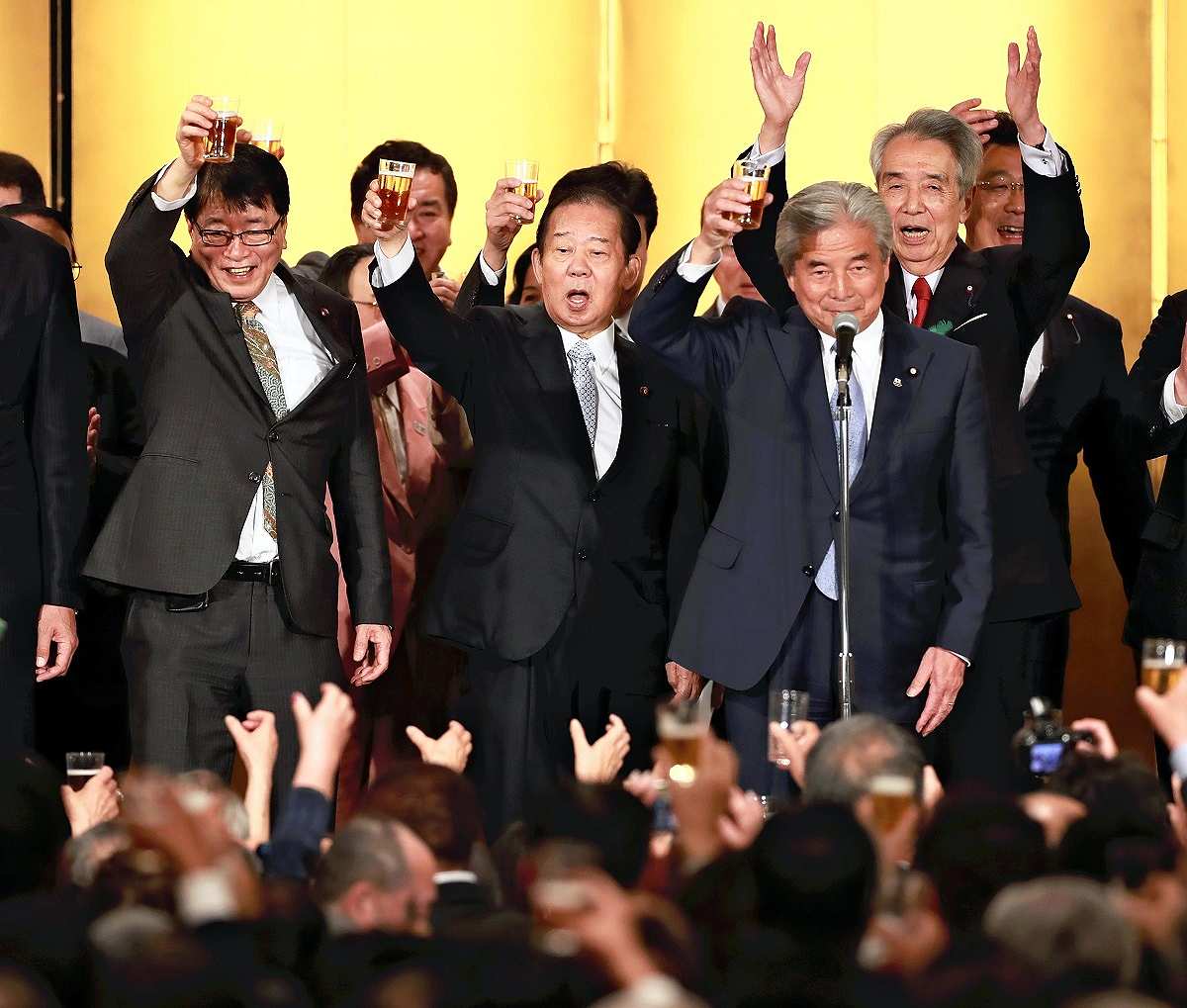
Liberal Democratic Party Secretary General Toshihiro Nikai, center, raises a glass during a fundraising party for his faction at a Tokyo hotel in May 2019.
The Yomiuri Shimbun
12:30 JST, November 30, 2020
The start of the administration led by Prime Minister Yoshihide Suga has been noted for the changing dynamics in the ruling Liberal Democratic Party. This series will examine the current state of the LDP by looking at factions that were thrust into the spotlight during the party’s presidential election. The following is the first installment of the series.
***
During a lunchtime meal at the Prime Minister’s Office on Nov. 12, Suga stopped eating his bowl of soba noodles to courteously express his thanks to LDP Secretary General Toshihiro Nikai, who was at the table: “Thanks to the secretary general, the party has been stable. I am forever grateful.” Nikai nodded his head appreciatively.
Arranged by Suga, the lunch was also attended by Motoo Hayashi, acting secretary general of the party and a close aide of Nikai. Suga spoke of the relationship he developed when he was chief cabinet secretary with a close aide to former U.S. Vice President Joe Biden, whose victory in the November U.S. presidential election has been secured. “Nurturing relationships of trust with partners is exactly what ‘Nikai diplomacy’ is all about,” Suga said.
The three men had dinner with Tokyo Gov. Yuriko Koike in the evening on the same day. Although Suga and Koike are known for not always seeing eye to eye, the prime minister promptly accepted a dinner invitation from Koike via Nikai. Suga has also called for a year-end party to be held with Nikai that is slated to take place in December.
The prime minister has long admired Nikai’s abilities and never fails to consider the veteran politician, whom he relies on to keep the party in check.
When then LDP Secretary General Sadakazu Tanigaki was seriously injured in a bicycle accident in 2016, it was Suga who advised then Prime Minister Shinzo Abe to appoint Nikai secretary general. When Abe considered replacing Nikai with Fumio Kishida as the party secretary general last year, Suga vehemently opposed the idea. “Do you really intend to replace him?” he reportedly asked Abe.
Although there are risks associated with Nikai’s occasionally high-handed methods, according to sources, Suga thought making an enemy of Nikai would imperil the management of the administration and that the best thing to do was to join hands with him.
The faction headed by Nikai is in the ascendant. Despite it being the fourth-largest faction in the party, it has been treated the most warmly when it comes to personnel appointments.
Other factions have expressed discontent, with at least one person saying it is “as if it were the LDP president’s faction,” but Nikai has shown no signs of being concerned. “If the prime minister and the secretary general [of the ruling party] weren’t on good terms, it would be a serious matter. [The administration] would fall apart,” Nikai has said.
However, even the Nikai faction might have some blind spots.
‘Go to the Nikai faction’
Laughter filled the room of a steakhouse in Ginza, Tokyo, on the evening of Oct. 19.
“This is the path everyone has taken. Work hard.”
After giving such marching orders to the two ministers and two state ministers appointed to the Suga Cabinet from his faction, Nikai took a swig from a glass of beer. Senior faction officials also on hand to celebrate the appointments then proffered their own congratulatory remarks. Nikai, seated at the middle table, beamed as he bit into his Saga beef.
Katsuei Hirasawa, the newly appointed reconstruction minister, listened to Nikai’s words with a flood of emotions. Hirasawa had been previously passed over for a cabinet post even though he had been elected to the House of Representatives eight times, well over the six considered as suitable for appointment. When one supporter said, “I cannot die until Hirasawa becomes a cabinet minister,” it brought a lump to his throat.
In 2017, Hirasawa left the faction led by Nobuteru Ishihara, where he was serving as secretary general, and jumped to the Nikai faction. In the latest personnel reshuffle, Nikai attached top priority to landing Hirasawa a cabinet post.
“If you want to get into the cabinet, go to the Nikai faction” was the half-serious joke circulating within the party. Among the veteran or mid-rank legislators who left other factions and became cabinet members for the first time after aligning with Nikai were Yoshitaka Sakurada, former minister for the Tokyo Olympic and Paralympic Games who had previously belonged to the faction of Fukushiro Nukaga, and Teru Fukui, former minister for Okinawa and northern territories affairs who had been in the Kishida faction.
The divine power of the Nikai faction does not end at the cabinet.
Nikai’s close aide Hayashi minced no words in a telephone call on Sept. 17 with Chief Cabinet Secretary Katsunobu Kato.
“If the Prime Minister’s Office wants to make personnel appointments on its own, then go ahead and do it,” Hayashi said. “But the party will never help again.”
Later, Hayashi would not answer the phone when Kato called back.
With cabinet approval of the appointments of state ministers and parliamentary vice-ministers slated for the following day, Kato was busy making final arrangements. The Nikai faction became truculent after not having been briefed in advance on the criteria the Prime Minister’s Office had set for the appointments, such as having been elected to the lower house at least three times.
The slate of personnel appointments was wiped clean, and the tentative selection of a parliamentary vice minister of the Cabinet Office was changed from a LDP member unaffiliated with any faction and elected to the lower house three times to a Nikai faction member who won a lower house seat twice.
It continued even with party leadership posts. In addition to the head of the accounting section, the Nikai faction secured the newly established post of acting chairman of the election committee — thus seizing control of the pivotal posts dealing with elections and money.
The Nikai faction’s expansionist line sparked friction with other factions.
“Hey, what are you going to do next?” Nikai pressed Mikio Shimoji, an independent member of the lower house who once belonged to the LDP, during a dinner at a Japanese restaurant in Akasaka, Tokyo, on Oct. 1.
Shimoji had been expelled from the Nippon Ishin no Kai (Japan Innovation Party) in January over cash he received from a Chinese company in connection with a bribery scandal linked to an integrated casino resort project. “Come to my place,” Nikai said, inviting Shimoji to join his faction.
When Shimoji pointed out that “the LDP’s prefectural chapter won’t allow me to return to the party,” Nikai replied bluntly: “It’s no big deal. All you have to do is work to convince the prefectural chapter.”
In the Okinawa No. 1 Constituency, Shimoji’s electoral base, Konosuke Kokuba of the Kishida faction serves as head of the local party chapter. Shimoji submitted a request to the Okinawa prefectural chapter to rejoin the party on Oct. 30, but Kokuba has taken an all-out stance of resistance against allowing him back.
The Nikai faction also has intraparty disputes in a wide range of constituencies, including Hokkaido No. 7, Gunma No. 1, Niigata No. 2 and Shizuoka No. 5. The party’s secretary general wields strong influence on who gains a place on the party ticket in elections. “The secretary general should devote himself to serving as a referee,” a veteran Kishida faction member said indignantly.
Should the Nikai faction continue to expand, the balance with the three other major factions — led by Hiroyuki Hosoda, Taro Aso and Wataru Takeshita — may break down. The escalation of conflicts between factions will destabilize the managing of the Suga administration. Suga does not belong to any faction and has a weak party following.
Nikai will turn 82 next February. The presence of Nikai is the source of the Nikai faction’s solidarity that overwhelms the other factions. But no name has been brought up that everyone would agree upon as a successor. When Komeito went with youth by appointing Keiichi Ishii as its new secretary general in September, Nikai raged, “Are they saying we should also make a generation change?”
A history of factions
A faction is group of legislators who join forces under a specific politician. Immediately after the Liberal Democratic Party was created in 1955, eight major factions formed that were dubbed the “eight army divisions.” Of the seven factions present today, all but the one led by Shigeru Ishiba have origins in the eight divisions. With the aim of becoming prime minister, the faction leader solidifies the group by allocating money and posts among its member legislators. In the 1970s and 1980s, the five major factions referred to as “San-Kaku-Dai-Fuku-Chu” — the factions led by Takeo Miki, Kakuei Tanaka, Masayoshi Ohira, Takeo Fukuda, and Yasuhiro Nakasone — were involved in fierce intraparty battles, leading to calls to dissolve the factions. The introduction of single-seat constituencies and party subsidies led to a transformation, with many factions no longer having the unifying force of the past and the aspect of an “information sharing group” growing stronger. No faction allows concurrent membership in other factions.
Popular Articles
Popular articles in the past 24 hours
-

Diplomacy with Central Asia: Utilize Long-Established Relationshi...
-
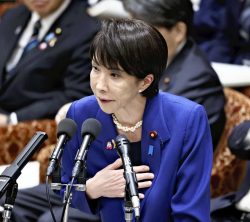
Poll Finds High Approval Rating for PM Takaichi’s Economic Measur...
-
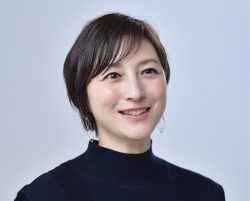
Japan Actor Ryoko Hirosue Given Summary Indictment over Car Accid...
-

Japanese Actors Haru, Mahiro Takasugi Announce Marriage
-

Japan Shares Rise as Bond Yields Retreat; Tech Jitters Weigh on N...
-

9 Japanese Police Officers Suspected of Online Casino Gambling
-

Hepburn Romaji Deemed Standard for Japanese Words, Names; Change ...
-
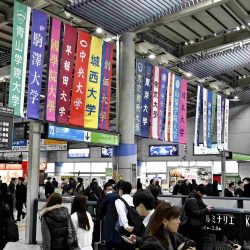
Hakone Ekiden Banners Hung at Tokyo's JR Shinagawa Station Ahead ...
Popular articles in the past week
-

Israeli Tourists Refused Accommodation at Hotel in Japan’s Nagano...
-

U.S. Senate Resolution Backs Japan, Condemns China's Pressure
-

Sharp Decline in Number of Chinese Tourists But Overall Number of...
-

Japan Set to Participate in EU's R&D Framework, Aims to Boost Coo...
-

China Attacks Japan at U.N. Security Council Meetings; Representa...
-

Japan Backs Public-Private Cooperation on Economic Security; Nati...
-

As Chinese Tourists Shun Japan, Hotels and Stores Suffer
-

Bus Bound for Hokkaido's New Chitose Airport Catches Fire Wednesd...
Popular articles in the past month
-

Tokyo Economic Security Forum to Hold Inaugural Meeting Amid Tens...
-

Keidanren Chairman Yoshinobu Tsutsui Visits Kashiwazaki-Kariwa Nu...
-

Imports of Rare Earths from China Facing Delays, May Be Caused by...
-

University of Tokyo Professor Discusses Japanese Economic Securit...
-

Japan Pulls out of Vietnam Nuclear Project, Complicating Hanoi's ...
-

Govt Aims to Expand NISA Program Lineup, Abolish Age Restriction
-

Blanket Eel Trade Restrictions Rejected
-

Key Japan Labor Group to Seek Pay Scale Hike
"Society" POPULAR ARTICLE
-

M4.9 Earthquake Hits Tokyo, Neighboring Prefectures
-

Israeli Tourists Refused Accommodation at Hotel in Japan’s Nagano Pref., Prompting Protest by Israeli Embassy and Probe by Prefecture
-

M7.5 Earthquake Hits Northern Japan; Tsunami Waves Observed in Hokkaido, Aomori and Iwate Prefectures
-

Tsukiji Market Urges Tourists to Avoid Visiting in Year-End
-

High School in Kyoto Says Students Shoplifted during Recent School Trip to Bali, Indonesia
JN ACCESS RANKING
-

Tokyo Economic Security Forum to Hold Inaugural Meeting Amid Tense Global Environment
-

Keidanren Chairman Yoshinobu Tsutsui Visits Kashiwazaki-Kariwa Nuclear Power Plant; Inspects New Emergency Safety System
-

Imports of Rare Earths from China Facing Delays, May Be Caused by Deterioration of Japan-China Relations
-

University of Tokyo Professor Discusses Japanese Economic Security in Interview Ahead of Forum
-

Japan Pulls out of Vietnam Nuclear Project, Complicating Hanoi’s Power Plans


